第二周测验
1. 神经元节点先计算线性函数(z = Wx + b),再计算激活。注:神经元的输出是 a = g(Wx + b),其中 g 是激活函数(sigmoid,tanh,ReLU,…)
2. 逻辑回归损失函数:𝐿(𝑦^(𝑖), 𝑦(𝑖)) = −𝑦(𝑖) log 𝑦^(𝑖)− (1 − 𝑦(𝑖))log(1 − 𝑦^(𝑖))
3. 假设 img 是一个(32,32,3)数组,具有 3 个颜色通道:红色、绿色和蓝色的 32x32 像素的图像。 如何将其重新转换为列向量?x = img.reshape((32 * 32 * 3, 1))
4.
a = np.random.randn(2, 3) # a.shape = (2, 3)
b = np.random.randn(2, 1) # b.shape = (2, 1)
c = a + b 请问数组 c 的维度是多少?c.shape = (2, 3)
5.
a = np.random.randn(4, 3) # a.shape = (4, 3)
b = np.random.randn(3, 2) # b.shape = (3, 2)
c = a * b请问数组“c”的维度是多少?运算符 “*” 说明了按元素乘法来相乘,但是元素乘法需要两个矩阵之间的维数相同,所以这将报错,无法计算。计算矩阵乘法应使用np.dot(a,b)
6. 假设你的每一个样本有𝒏𝒙个输入特征,想一下在 𝑿 = [𝒙(𝟏), 𝒙(𝟐) … 𝒙(𝒎)] 中,X 的维度是多少?(𝑛𝑥, 𝑚)
7.
a = np.random.randn(12288, 150) # a.shape = (12288, 150)
b = np.random.randn(150, 45) # b.shape = (150, 45)
c = np.dot(a, b)请问 c 的维度是多少?c.shape = (12288, 45)
8.
# a.shape = (3,4)
# b.shape = (4,1)
for i in range(3):
for j in range(4):
c[i][j] = a[i][j] + b[j]请问要怎么把它们向量化?c = a + b.T
9.
a = np.random.randn(3, 3)
b = np.random.randn(3, 1)
c = a * b请问 c 的维度会是多少? 这将会使用广播机制,b 会被复制三次,就会变成 (3,3),再使用元素乘法。所以: c.shape = (3, 3)
10.
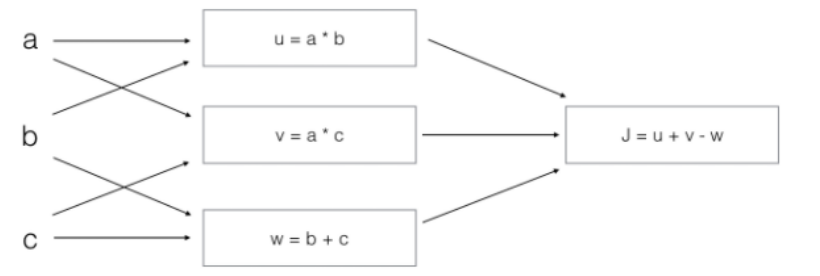 问J输出什么?
问J输出什么?
J = u + v - w
= a * b + a * c - (b + c)
= a * (b + c) - (b + c)
= (a - 1) * (b + c)
第二周作业
Logistic Regression with a Neural Network mindset
欢迎来到您的第一个(必修课)编程作业!您将构建一个逻辑回归分类器来识别猫。这个作业将指导你如何用神经网络的心态来做这件事,因此也将磨练你关于深度学习的直觉。
产品说明:
- 不要在代码中使用循环(for/while),除非指令明确要求这样做。
你将学会:
- 构建一个学习算法的总体架构,包括:
- 初始化参数
- 计算代价函数及其梯度
- 使用一种优化算法(梯度下降)
- 按照正确的顺序将上面的三个函数聚集到一个主模型函数中。
1 - Packages
首先,让我们运行下面的单元格来导入在此任务期间需要的所有包。
- numpy是使用Python进行科学计算的基本包。
- h5py是一个通用包,用于与存储在H5文件中的数据集进行交互。
- matplotlib是Python中用于绘制图形的著名库。
- 这里用PIL和scipy来测试你的模型,最后用你自己的图片。
import numpy as np
import matplotlib.pyplot as plt
import h5py
import scipy
from PIL import Image
from scipy import ndimage
from lr_utils import load_dataset
%matplotlib inline2 - Overview of the Problem set
问题陈述:你被给了一个数据集(“data.h5”),包含:-一个m_train图像的训练集,标记为猫(y=1)或非猫(y=0) -一个m_test图像的测试集,标记为猫或非猫-每个图像的形状(num_px, num_px, 3),其中
3是3个通道(RGB)。因此,每个图像都是正方形(高度= num_px)和正方形(宽度= num_px)。
您将构建一个简单的图像识别算法,可以正确地将图片分类为猫或非猫。
让我们更加熟悉数据集。通过运行以下代码加载数据。
# Loading the data (cat/non-cat)
train_set_x_orig, train_set_y, test_set_x_orig, test_set_y, classes = load_dataset()我们在图像数据集(训练和测试)的末尾添加了“_trans”,因为我们要对它们进行预处理。预处理之后,我们将得到train_set_x和test_set_x(标签train_set_y和test_set_y不需要任何预处理)。
train_set_x_orig和test_set_x_orig的每一行都是一个表示图像的数组。您可以通过运行以下代码来可视化示例。您也可以随意更改索引值并重新运行以查看其他图像。
# Example of a picture
index = 5
plt.imshow(train_set_x_orig[index])
print ("y = " + str(train_set_y[:, index]) + ", it's a '" + classes[np.squeeze(train_set_y[:, index])].decode("utf-8") + "' picture.")y = [0], it's a 'non-cat' picture.
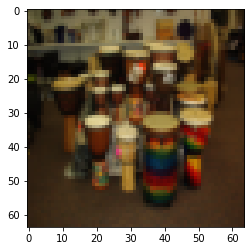
深度学习中的许多软件bug来自于矩阵/向量维度不匹配。如果你能保持矩阵/向量维数的平直,你就能在消除许多bug方面大有作为。
- m_train(训练示例的数量)- m_test(测试示例的数量)- num_px (= height =训练图像的宽度)记住train_set_x_orig是一个维度为(m_train, num_px, num_px, 3)的numpy数组。例如,你可以通过编写train_set_x_orig.shape[0]来访问m_train。
### START CODE HERE ### (≈ 3 lines of code)
m_train = train_set_x_orig.shape[0]
m_test = test_set_x_orig.shape[0]
num_px = train_set_x_orig.shape[1]
### END CODE HERE ###
print ("Number of training examples: m_train = " + str(m_train))
print ("Number of testing examples: m_test = " + str(m_test))
print ("Height/Width of each image: num_px = " + str(num_px))
print ("Each image is of size: (" + str(num_px) + ", " + str(num_px) + ", 3)")
print ("train_set_x shape: " + str(train_set_x_orig.shape))
print ("train_set_y shape: " + str(train_set_y.shape))
print ("test_set_x shape: " + str(test_set_x_orig.shape))
print ("test_set_y shape: " + str(test_set_y.shape))Number of training examples: m_train = 209 Number of testing examples: m_test = 50 Height/Width of each image: num_px = 64 Each image is of size: (64, 64, 3) train_set_x shape: (209, 64, 64, 3) train_set_y shape: (1, 209) test_set_x shape: (50, 64, 64, 3) test_set_y shape: (1, 50)
Expected Output for m_train, m_test and num_px:
| **m_train** | 209 |
| **m_test** | 50 |
| **num_px** | 64 |
为了方便,现在应该在numpy数组(num_px * num_px * 3,1)中重塑维度(num_px, num_px, 3)的图像。在此之后,我们的训练(和测试)数据集是一个numpy数组,其中每一列表示一个扁平图像。应该有m_train(分别是m_test)列。
重塑训练和测试数据集,使大小(num_px, num_px, 3)的图像被平展成单个形状向量(num_px * num_px * 3,1)。
当你想要将形状矩阵X (A,b,c,d)平化为形状矩阵X_flatten (b∗c∗d, A)时,有一个技巧要使用:
X_flatten = X.reshape(X.shape[0], -1).T # X.T is the transpose of X# Reshape the training and test examples
### START CODE HERE ### (≈ 2 lines of code)
train_set_x_flatten = train_set_x_orig.reshape(train_set_x_orig.shape[0], -1).T
test_set_x_flatten = test_set_x_orig.reshape(test_set_x_orig.shape[0], -1).T
### END CODE HERE ###
print ("train_set_x_flatten shape: " + str(train_set_x_flatten.shape))
print ("train_set_y shape: " + str(train_set_y.shape))
print ("test_set_x_flatten shape: " + str(test_set_x_flatten.shape))
print ("test_set_y shape: " + str(test_set_y.shape))
print ("sanity check after reshaping: " + str(train_set_x_flatten[0:5,0]))Expected Output:
| **train_set_x_flatten shape** | (12288, 209) |
| **train_set_y shape** | (1, 209) |
| **test_set_x_flatten shape** | (12288, 50) |
| **test_set_y shape** | (1, 50) |
| **sanity check after reshaping** | [17 31 56 22 33] |
为了表示彩色图像,必须为每个像素指定红、绿和蓝通道(RGB),因此像素值实际上是一个由0到255三个数字组成的向量。
机器学习中一个常见的预处理步骤是集中并标准化数据集,这意味着从每个示例中减去整个numpy数组的平均值,然后将每个示例除以整个numpy数组的标准差。但是对于图片数据集,将数据集的每一行除以255(像素通道的最大值)就更简单、更方便了。
让我们标准化数据集。
train_set_x = train_set_x_flatten/255.
test_set_x = test_set_x_flatten/255.你需要记住的是:
预处理新数据集的常见步骤如下:
- 找出问题的尺寸和形状(m_train, m_test, num_px,…)
- 重塑数据集,使每个示例现在都是一个大小向量(num_px * num_px * 3,1)
- “标准化”的数据
3 - General Architecture of the learning algorithm
现在是时候设计一个简单的算法来区分猫图像和非猫图像了。
你将建立一个逻辑回归,使用神经网络思维。下图解释了为什么逻辑回归实际上是一个非常简单的神经网络!
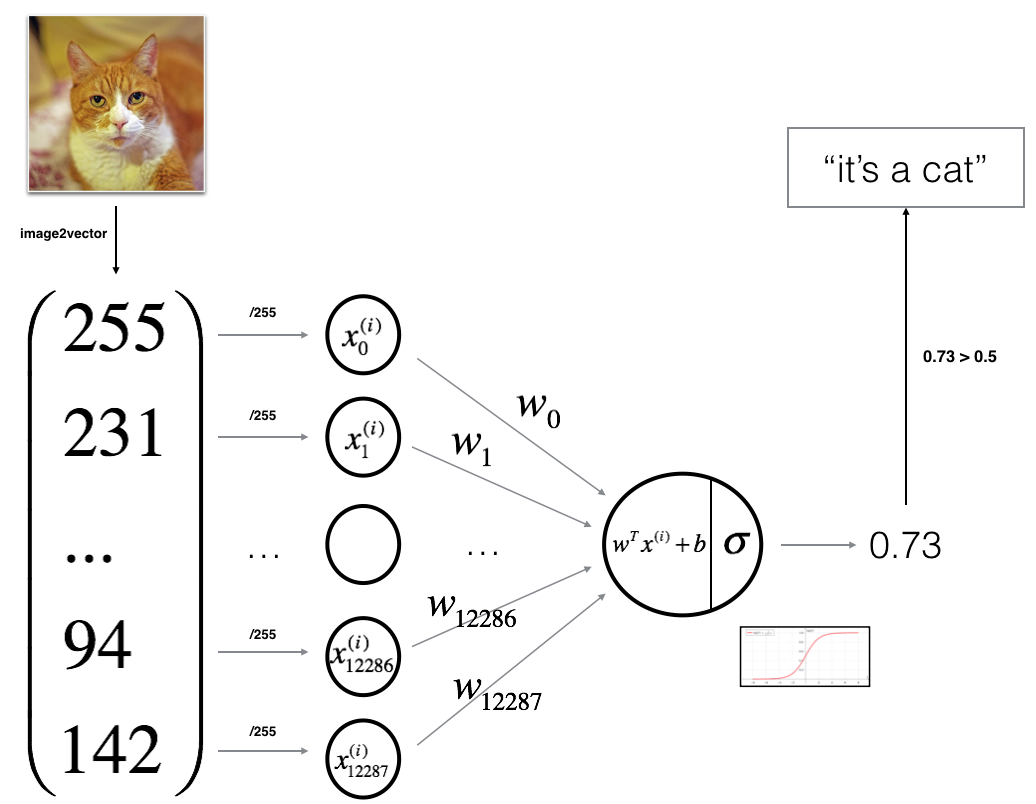
Mathematical expression of the algorithm:

关键步骤:在本练习中,您将执行以下步骤:—初始化模型参数—通过最小化成本来学习模型参数
-使用学习到的参数进行预测(在测试集上)-分析结果并得出结论
4 - Building the parts of our algorithm
构建神经网络的主要步骤是:
建立神经网络的主要步骤是:
-
定义模型结构(例如输入特征的数量)
-
初始化模型的参数
-
循环:
3.1 计算当前损失(正向传播)
3.2 计算当前梯度(反向传播)
3.3 更新参数(梯度下降)
分别构建上述1-3,并将它们集成到一个函数中,我们称之为model()。
4.1 -辅助功能
使用“Python基础”中的代码,实现sigmoid()。正如您所看到的在上面的图中,需要计算进行预测。,使用np.exp()。
# GRADED FUNCTION: sigmoid
def sigmoid(z):
"""
Compute the sigmoid of z
Arguments:
z -- A scalar or numpy array of any size.
Return:
s -- sigmoid(z)
"""
### START CODE HERE ### (≈ 1 line of code)
s = 1 / (1 + np.exp(-z))
### END CODE HERE ###
return sprint ("sigmoid([0, 2]) = " + str(sigmoid(np.array([0,2]))))Expected Output:
| **sigmoid([0, 2])** | [ 0.5 0.88079708] |
4.2 -初始化参数
在下面的单元格中实现参数初始化。你必须把w初始化为一个零向量。如果您不知道要使用什么numpy函数,请在numpy库的文档中查找np.zeros()。
# GRADED FUNCTION: initialize_with_zeros
def initialize_with_zeros(dim):
"""
This function creates a vector of zeros of shape (dim, 1) for w and initializes b to 0.
Argument:
dim -- size of the w vector we want (or number of parameters in this case)
Returns:
w -- initialized vector of shape (dim, 1)
b -- initialized scalar (corresponds to the bias)
"""
### START CODE HERE ### (≈ 1 line of code)
w = np.zeros((dim, 1))
b = 0
### END CODE HERE ###
assert(w.shape == (dim, 1))
assert(isinstance(b, float) or isinstance(b, int))
return w, bdim = 2
w, b = initialize_with_zeros(dim)
print ("w = " + str(w))
print ("b = " + str(b))Expected Output:
| ** w ** | [[ 0.] [ 0.]] |
| ** b ** | 0 |
For image inputs, w will be of shape (num_px * num_px * 3, 1).
4.3 -向前和向后传播
现在已经初始化了参数,您可以执行“向前”和“向后”传播步骤来学习参数。
实现一个propagate()函数,该函数计算代价函数及其梯度。
提示:

# GRADED FUNCTION: propagate
def propagate(w, b, X, Y):
"""
Implement the cost function and its gradient for the propagation explained above
Arguments:
w -- weights, a numpy array of size (num_px * num_px * 3, 1)
b -- bias, a scalar
X -- data of size (num_px * num_px * 3, number of examples)
Y -- true "label" vector (containing 0 if non-cat, 1 if cat) of size (1, number of examples)
Return:
cost -- negative log-likelihood cost for logistic regression
dw -- gradient of the loss with respect to w, thus same shape as w
db -- gradient of the loss with respect to b, thus same shape as b
Tips:
- Write your code step by step for the propagation. np.log(), np.dot()
"""
m = X.shape[1]
# FORWARD PROPAGATION (FROM X TO COST)
### START CODE HERE ### (≈ 2 lines of code)
Z = np.dot(w.T, X) + b
A = sigmoid(Z)
cost = 1/m * np.sum(-Y*np.log(A)-(1-Y)*np.log(1-A))
### END CODE HERE ###
# BACKWARD PROPAGATION (TO FIND GRAD)
### START CODE HERE ### (≈ 2 lines of code)
dZ = A - Y
dw = 1/m * np.dot(X, dZ.T)
db = 1/m * np.sum(dZ)
### END CODE HERE ###
assert(dw.shape == w.shape)
assert(db.dtype == float)
cost = np.squeeze(cost)
assert(cost.shape == ())
grads = {"dw": dw,
"db": db}
return grads, costw, b, X, Y = np.array([[1],[2]]), 2, np.array([[1,2],[3,4]]), np.array([[1,0]])
grads, cost = propagate(w, b, X, Y)
print ("dw = " + str(grads["dw"]))
print ("db = " + str(grads["db"]))
print ("cost = " + str(cost))Expected Output:
| ** dw ** | [[ 0.99993216] [ 1.99980262]] |
| ** db ** | 0.499935230625 |
| ** cost ** | 6.000064773192205 |
d)优化
- 您已经初始化了参数。
- 你也可以计算一个代价函数和它的梯度。
- 现在,您希望使用梯度下降来更新参数。
练习:写出优化函数。目标是通过最小化成本函数𝐽来学习𝑤和𝑏。对于𝜃,更新规则为𝜃=𝜃−𝛼𝑑𝜃,其中𝛼为学习率。
params, grads, costs = optimize(w, b, X, Y, num_iterations= 100, learning_rate = 0.009, print_cost = False)
print ("w = " + str(params["w"]))
print ("b = " + str(params["b"]))
print ("dw = " + str(grads["dw"]))
print ("db = " + str(grads["db"]))
print(costs)w = [[0.1124579 ] [0.23106775]] b = 1.5593049248448891 dw = [[0.90158428] [1.76250842]] db = 0.4304620716786828 [6.000064773192205]
前面的函数将输出学习到的w和b。我们可以使用w和b来预测数据集x的标签。计算预测有两个步骤:
- 计算𝑌̂=𝐴=𝜎(𝑤𝑇𝑋+𝑏)
- 将a的条目转换为0(如果激活<= 0.5)或1(如果激活> 0.5),将预测存储在Y_prediction向量中。如果您愿意,您可以在for循环中使用If /else语句(尽管也有一种方法对其进行向量化)。
# GRADED FUNCTION: predict
def predict(w, b, X):
'''
Predict whether the label is 0 or 1 using learned logistic regression parameters (w, b)
Arguments:
w -- weights, a numpy array of size (num_px * num_px * 3, 1)
b -- bias, a scalar
X -- data of size (num_px * num_px * 3, number of examples)
Returns:
Y_prediction -- a numpy array (vector) containing all predictions (0/1) for the examples in X
'''
m = X.shape[1]
Y_prediction = np.zeros((1,m))
w = w.reshape(X.shape[0], 1)
# Compute vector "A" predicting the probabilities of a cat being present in the picture
### START CODE HERE ### (≈ 1 line of code)
A = sigmoid(np.dot(w.T, X) + b)
### END CODE HERE ###
for i in range(A.shape[1]):
# Convert probabilities A[0,i] to actual predictions p[0,i]
### START CODE HERE ### (≈ 4 lines of code)
Y_prediction[0,i] = 1 if A[0,i] > 0.5 else 0
### END CODE HERE ###
assert(Y_prediction.shape == (1, m))
return Y_predictionprint ("predictions = " + str(predict(w, b, X)))Expected Output:
| **predictions** | [[ 1. 1.]] |
记住:你已经实现了几个函数:-初始化(w,b) -优化损失迭代学习参数(w,b): -计算成本和其梯度-使用梯度下降更新参数-使用学习(w,b)预测标签为给定的一组示例
5 - Merge all functions into a model
现在,您将看到如何通过将所有构建块(前面部分中实现的函数)以正确的顺序组合在一起来构建整个模型。
实现模型函数。使用以下符号:—Y_prediction用于测试集上的预测—Y_prediction_train用于训练集上的预测—w、成本、梯度用于optimize()的输出
# GRADED FUNCTION: model
def model(X_train, Y_train, X_test, Y_test, num_iterations = 2000, learning_rate = 0.5, print_cost = False):
"""
Builds the logistic regression model by calling the function you've implemented previously
Arguments:
X_train -- training set represented by a numpy array of shape (num_px * num_px * 3, m_train)
Y_train -- training labels represented by a numpy array (vector) of shape (1, m_train)
X_test -- test set represented by a numpy array of shape (num_px * num_px * 3, m_test)
Y_test -- test labels represented by a numpy array (vector) of shape (1, m_test)
num_iterations -- hyperparameter representing the number of iterations to optimize the parameters
learning_rate -- hyperparameter representing the learning rate used in the update rule of optimize()
print_cost -- Set to true to print the cost every 100 iterations
Returns:
d -- dictionary containing information about the model.
"""
### START CODE HERE ###
# initialize parameters with zeros (≈ 1 line of code)
w , b = initialize_with_zeros(X_train.shape[0])
# Gradient descent (≈ 1 line of code)
parameters , grads , costs = optimize(w , b , X_train , Y_train, num_iterations , learning_rate , print_cost)
# Retrieve parameters w and b from dictionary "parameters"
w , b = parameters["w"] , parameters["b"]
# Predict test/train set examples (≈ 2 lines of code)
Y_prediction_test = predict(w , b, X_test)
Y_prediction_train = predict(w , b, X_train)
### END CODE HERE ###
# Print train/test Errors
print("train accuracy: {} %".format(100 - np.mean(np.abs(Y_prediction_train - Y_train)) * 100))
print("test accuracy: {} %".format(100 - np.mean(np.abs(Y_prediction_test - Y_test)) * 100))
d = {"costs": costs,
"Y_prediction_test": Y_prediction_test,
"Y_prediction_train" : Y_prediction_train,
"w" : w,
"b" : b,
"learning_rate" : learning_rate,
"num_iterations": num_iterations}
return dd = model(train_set_x, train_set_y, test_set_x, test_set_y, num_iterations = 2000, learning_rate = 0.005, print_cost = True)Cost after iteration 0: 0.693147 Cost after iteration 100: 0.584508 Cost after iteration 200: 0.466949 Cost after iteration 300: 0.376007 Cost after iteration 400: 0.331463 Cost after iteration 500: 0.303273 Cost after iteration 600: 0.279880 Cost after iteration 700: 0.260042 Cost after iteration 800: 0.242941 Cost after iteration 900: 0.228004 Cost after iteration 1000: 0.214820 Cost after iteration 1100: 0.203078 Cost after iteration 1200: 0.192544 Cost after iteration 1300: 0.183033 Cost after iteration 1400: 0.174399 Cost after iteration 1500: 0.166521 Cost after iteration 1600: 0.159305 Cost after iteration 1700: 0.152667 Cost after iteration 1800: 0.146542 Cost after iteration 1900: 0.140872 train accuracy: 99.04306220095694 % test accuracy: 70.0 %
点评:训练准确率接近100%。这是一个很好的完整性检查:您的模型正在工作,并且具有足够高的容量来拟合训练数据。测试误差为68%。对于这个简单的模型来说,它实际上并不坏,因为我们使用的数据集很小,而且逻辑回归是一个线性分类器。但不用担心,下周您将构建一个更好的分类器!
此外,您可以看到,该模型显然对训练数据进行了过拟合。在本专题的后面,您将学习如何减少过拟合,例如使用正则化。使用下面的代码(并更改索引变量),您可以查看测试集图片上的预测。
# Plot learning curve (with costs)
costs = np.squeeze(d['costs'])
plt.plot(costs)
plt.ylabel('cost')
plt.xlabel('iterations (per hundreds)')
plt.title("Learning rate =" + str(d["learning_rate"]))
plt.show()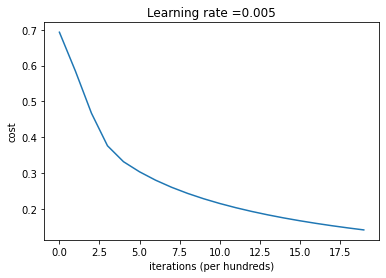
解读:你可以看到成本在下降。这表明参数正在被学习。但是,您可以看到,您可以在训练集中对模型进行更多的训练。尝试增加上面单元格中的迭代次数,并重新运行单元格。你可能会发现训练集的准确率上升了,但测试集的准确率下降了。这叫做过拟合。
6 - Further analysis (optional/ungraded exercise)
祝贺您建立了第一个图像分类模型。让我们进一步分析它,并检查学习率𝛼的可能选择。
学习速率的选择:
提醒:为了让梯度下降发挥作用,你必须明智地选择学习率。学习率𝛼决定了我们更新参数的速度。如果学习率太大,我们可能会“超过”最优值。类似地,如果它太小,我们将需要太多的迭代才能收敛到最佳值。这就是为什么使用一个良好的学习率是至关重要的。
让我们将模型的学习曲线与几种学习率的选择进行比较。运行下面的单元格。这个过程大约需要1分钟。您也可以尝试不同的值,而不是我们初始化的learning_rates变量所包含的三个值,看看会发生什么。
learning_rates = [0.01, 0.001, 0.0001]
models = {}
for i in learning_rates:
print ("learning rate is: " + str(i))
models[str(i)] = model(train_set_x, train_set_y, test_set_x, test_set_y, num_iterations = 1500, learning_rate = i, print_cost = False)
print ('\n' + "-------------------------------------------------------" + '\n')
for i in learning_rates:
plt.plot(np.squeeze(models[str(i)]["costs"]), label= str(models[str(i)]["learning_rate"]))
plt.ylabel('cost')
plt.xlabel('iterations')
legend = plt.legend(loc='upper center', shadow=True)
frame = legend.get_frame()
frame.set_facecolor('0.90')
plt.show()learning rate is: 0.01 train accuracy: 99.52153110047847 % test accuracy: 68.0 % ------------------------------------------------------- learning rate is: 0.001 train accuracy: 88.99521531100478 % test accuracy: 64.0 % ------------------------------------------------------- learning rate is: 0.0001 train accuracy: 68.42105263157895 % test accuracy: 36.0 % -------------------------------------------------------
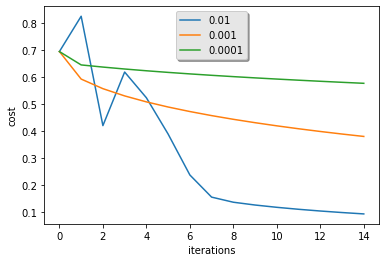
解释:
- 不同的学习率会带来不同的成本,从而导致不同的预测结果。
- 如果学习率太大(0.01),代价可能会上下振荡。它甚至可能会产生分歧(尽管在本例中,使用0.01最终仍然会获得较好的成本值)。
- 更低的成本并不意味着更好的模式。你必须检查是否有可能过度拟合。当训练的准确度远远高于测试的准确度时,就会出现这种情况。
- 在深度学习中,我们通常推荐你:
- 选择能使代价函数最小的学习率。
- 如果你的模型过度拟合,使用其他技术来减少过度拟合。(我们会在后面的视频中讲到)
逻辑回归关键代码
# 导入包
import numpy as np
import matplotlib.pyplot as plt
"""
计算z的sigmoid函数
参数:
z -- 任何大小的标量或numpy数组
返回:
s -- sigmoid(z)
"""
def sigmoid(z):
s = 1 / (1 + np.exp(-z))
return s
"""
此函数为w创建一个维度为(dim,1)的0向量,并将b初始化为0。
参数:
dim - 我们想要的w矢量的大小(或者这种情况下的参数数量)
返回:
w - 维度为(dim,1)的初始化向量。
b - 初始化的标量(对应于偏差)
"""
def initialize_with_zeros(dim):
w = np.zeros(shape = (dim,1))
b = 0
#使用断言来确保我要的数据是正确的
assert(w.shape == (dim, 1)) #w的维度是(dim,1)
assert(isinstance(b, float) or isinstance(b, int)) #b的类型是float或者是int
return (w , b)
"""
实现前向和后向传播的成本函数及其梯度。
参数:
w - 权重,大小不等的数组(num_px * num_px * 3,1)
b - 偏差,一个标量
X - 矩阵类型为(num_px * num_px * 3,训练数量)
Y - 真正的“标签”矢量(如果非猫则为0,如果是猫则为1),矩阵维度为(1,训练数据数量)
返回:
cost- 逻辑回归的负对数似然成本
dw - 相对于w的损失梯度,因此与w相同的形状
db - 相对于b的损失梯度,因此与b的形状相同
"""
def propagate(w, b, X, Y):
m = X.shape[1]
#正向传播
A = sigmoid(np.dot(w.T,X) + b)
cost = (- 1 / m) * np.sum(Y * np.log(A) + (1 - Y) * (np.log(1 - A)))
#反向传播
dw = (1 / m) * np.dot(X, (A - Y).T)
db = (1 / m) * np.sum(A - Y)
#使用断言确保我的数据是正确的
assert(dw.shape == w.shape)
assert(db.dtype == float)
cost = np.squeeze(cost)
assert(cost.shape == ())
#创建一个字典,把dw和db保存起来。
grads = {
"dw": dw,
"db": db
}
return (grads , cost)
"""
此函数通过运行梯度下降算法来优化w和b
参数:
w - 权重,大小不等的数组(num_px * num_px * 3,1)
b - 偏差,一个标量
X - 维度为(num_px * num_px * 3,训练数据的数量)的数组。
Y - 真正的“标签”矢量(如果非猫则为0,如果是猫则为1),矩阵维度为(1,训练数据的数量)
num_iterations - 优化循环的迭代次数
learning_rate - 梯度下降更新规则的学习率
print_cost - 每100步打印一次损失值
返回:
params - 包含权重w和偏差b的字典
grads - 包含权重和偏差相对于成本函数的梯度的字典
成本 - 优化期间计算的所有成本列表,将用于绘制学习曲线。
提示:
我们需要写下两个步骤并遍历它们:
1)计算当前参数的成本和梯度,使用propagate()。
2)使用w和b的梯度下降法则更新参数。
"""
def optimize(w , b , X , Y , num_iterations , learning_rate , print_cost = False):
costs = []
for i in range(num_iterations):
grads, cost = propagate(w, b, X, Y)
dw = grads["dw"]
db = grads["db"]
w = w - learning_rate * dw
b = b - learning_rate * db
#记录成本 每迭代100次记录一次
if i % 100 == 0:
costs.append(cost)
#打印成本数据
if (print_cost) and (i % 100 == 0):
print("迭代的次数: %i , 误差值: %f" % (i,cost))
params = {
"w" : w,
"b" : b }
grads = {
"dw": dw,
"db": db }
return (params , grads , costs)
"""
使用学习逻辑回归参数logistic (w,b)预测标签是0还是1,
参数:
w - 权重,大小不等的数组(num_px * num_px * 3,1)
b - 偏差,一个标量
X - 维度为(num_px * num_px * 3,训练数据的数量)的数据
返回:
Y_prediction - 包含X中所有图片的所有预测【0 | 1】的一个numpy数组(向量)
"""
def predict(w , b , X ):
m = X.shape[1] #样本的数量
Y_prediction = np.zeros((1,m))
w = w.reshape(X.shape[0],1)
#计预测猫在图片中出现的概率
A = sigmoid(np.dot(w.T , X) + b)
for i in range(A.shape[1]):
#将概率a [0,i]转换为实际预测p [0,i]
Y_prediction[0,i] = 1 if A[0,i] > 0.5 else 0
#使用断言
assert(Y_prediction.shape == (1,m))
return Y_prediction
"""
通过调用之前实现的函数来构建逻辑回归模型
参数:
X_train - numpy的数组,维度为(num_px * num_px * 3,m_train)的训练集
Y_train - numpy的数组,维度为(1,m_train)(矢量)的训练标签集
X_test - numpy的数组,维度为(num_px * num_px * 3,m_test)的测试集
Y_test - numpy的数组,维度为(1,m_test)的(向量)的测试标签集
num_iterations - 表示用于优化参数的迭代次数的超参数
learning_rate - 表示optimize()更新规则中使用的学习速率的超参数
print_cost - 设置为true以每100次迭代打印成本
返回:
d - 包含有关模型信息的字典。
"""
def model(X_train , Y_train , X_test , Y_test , num_iterations = 2000 , learning_rate = 0.5 , print_cost = False):
w , b = initialize_with_zeros(X_train.shape[0])
parameters , grads , costs = optimize(w , b , X_train , Y_train, num_iterations , learning_rate , print_cost)
#从字典“参数”中检索参数w和b
w , b = parameters["w"] , parameters["b"]
#预测测试/训练集的例子
Y_prediction_test = predict(w , b, X_test)
Y_prediction_train = predict(w , b, X_train)
#打印训练后的准确性
print("训练集准确性:" , format(100 - np.mean(np.abs(Y_prediction_train - Y_train)) * 100) ,"%")
print("测试集准确性:" , format(100 - np.mean(np.abs(Y_prediction_test - Y_test)) * 100) ,"%")
d = {
"costs" : costs,
"Y_prediction_test" : Y_prediction_test,
"Y_prediciton_train" : Y_prediction_train,
"w" : w,
"b" : b,
"learning_rate" : learning_rate,
"num_iterations" : num_iterations
}
return d






















 913
913











 被折叠的 条评论
为什么被折叠?
被折叠的 条评论
为什么被折叠?








